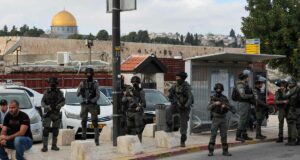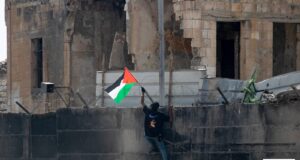18 June 2009
On Friday, 5 June 2009, ‘Aqel Sror, 35, was killed when a border policeman fired a live, 0.22 inch caliber bullet at his chest during a demonstration held in Ni’lin. Four other demonstrators were injured by 0.22 bullets that day. One of them suffered a severe wound to the spinal cord, which his physicians estimate will leave him permanently paralyzed.
B’Tselem’s investigation indicates that Sror, who was part of a group of youths who were throwing stones at border policemen, was shot while he ran to aid a young man who had been injured a few seconds earlier. The shot was fired by a Border Police sniper, from a distance of 40 to 50 meters away. Sror and the injured person whom he had gone to aid were struck in their torsos. B’Tselem demanded a criminal investigation in the matter.
0.22 bullets are live ammunition that used to be fired from a Ruger rifle. Their impact may be lower, but they do cause injury, at times very serious, and even death. For this reason, the former Judge Advocate General, Maj. Gen. Menachem Finkelstein, ordered that use of these bullets stop. The order was given in 2001 after several children in the Gaza Strip were killed by this ammunition, and after OC Central Command had already prohibited its use. At the time, Ha’aretz quoted an army official who saying that “the mistake was that the Ruger came to be seen as a means to disperse demonstrators, although it was originally intended to be a weapon to all intents and purposes.”
Surprisingly, a few months ago, the army returned to using this ammunition to disperse demonstrators, without giving any explanation for this sudden change in policy and without taking any measures to prevent the expected injury to civilians. Indeed, since then, 0.22 bullets have killed or injured many Palestinians in the West Bank, and also at least one foreigner. In February, ‘Az a-Din al-Jamal, 14, was killed in Hebron when after throwing stones with other youths. B’Tselem also knows of persons who were injured in Ni’lin, Bil’in, Jayyus, Bitunya, and Budrus. Most of the victims were struck in the legs, suffering light to moderate injuries.
Following the renewed use of 0.22 bullets, B’Tselem wrote to the Judge Advocate General in March warning of the potential danger lives in use of this ammunition to disperse demonstrations. The response of Maj. Yehoshua Gortler, of the Judge Advocate General’s Office, was received only in June, after ‘Aqel Sror was killed, and after another letter from B’Tselem.
In his response, Major Gortler states that the rules applying to 0.22 bullets are “comparable, in general, to the the Open-Fire Regulations applying to ‘ordinary’ live ammunition… The IDF does not consider the Ruger rifle a means to disperse demonstrators or persons engaged in public disturbances, and the weapon is not a substitute for means used to deal with public disturbances (such as stun grenades, rubber bullets, and so forth).”
This response does not reflect the reality in the field. B’Tselem’s observations at demonstrations in Ni’lin clearly indicate that security forces have consistently used 0.22 bullets since the end of 2008, and that they see them as an additional means to disperse demonstrators.
First, following the killing of ‘Aqel Sror, the IDF Spokesperson himself stated that soldiers had fired at demonstrators with a Ruger rifle, “which is a means to disperse demonstrators that fires ammunition similar to live ammunition but at low intensity.”
Second, soldiers frequently use 0.22 bullets along with other crowd-dispersal means, such as tear gas and stun grenades. This conduct indicates that soldiers in the field and their commanders see 0.22 bullets as one of the means available to them for dispersing demonstrators.
Third, soldiers often do not have any weapon suited to shooting rubber-coated metal bullets, which are intended for crowd dispersal. Rather, they only have 0.22 bullets. This situation is reflected in the number of demonstrators wounded by these bullets in Ni’lin: since the army renewed use of these bullets, at least 28 demonstrators have been injured.
Fourth, analysis of the repeated use of 0.22 bullets in demonstrations in Ni’lin clearly demonstrates that, in the vast majority of cases, neither soldiers nor other persons were in life-threatening situations, which is the only case in which it is permitted to use live ammunition.
In its letters to the Judge Advocate General, B’Tselem noted that treating 0.22 bullets as a means for dispersing demonstrators has led security forces to see this ammunition as non-lethal and harmless, whose use does not have be restricted. Accordingly, forces have increased use of it and have begun to fire it in non-life-threatening situations.
This incorrect perception is especially dangerous because soldiers are almost never held accountable for illegal use of weapons. The lack of accountability results from the Judge Advocate General’s Office’s policy of not opening Military Police investigations in cases in which Palestinians are killed or wounded, except in rare circumstances in which the operational investigation, made by the same soldiers who caused the injury, raises a suspicion of criminal conduct. This policy has led to very few investigations, and consequently grants impunity to soldiers who breach the law.
B’Tselem demands that the army immediately cease use of 0.22 ammunition in circumstances that are not life-threatening, and that measures be taken against members of the security forces who have opened fire in breach of the regulations, causing death or injury to civilians.
 International Solidarity Movement Nonviolence. Justice. Freedom.
International Solidarity Movement Nonviolence. Justice. Freedom.


